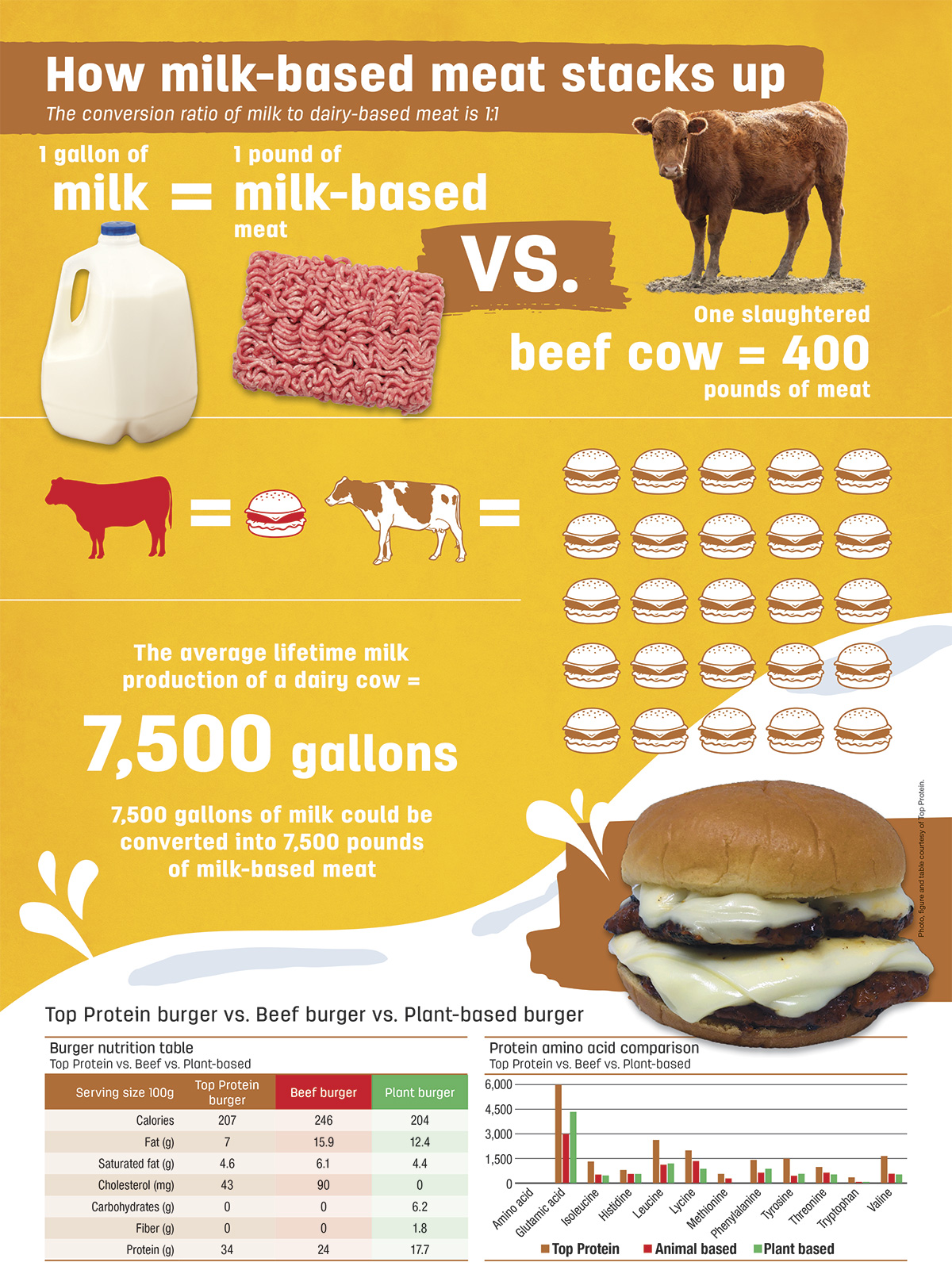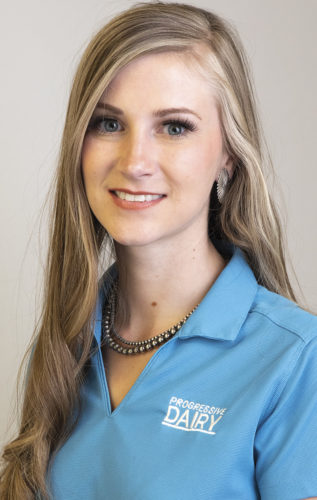Top Protein, a 3-year-old startup company with decades of protein knowledge, has created dairy-based meat made from milk.
“I've been working with milk proteins for over 20 years,” says Chip Marsland, CEO and founder of Top Protein. “Milk proteins are something I'm quite intimately familiar with due to their superior nutritional composition and their amino acid profile and digestibility. If you look at the composition of a milk protein, it's really meant to help the recipient to grow, live and heal.”
Marsland has an extensive background in biotechnology and has been at the forefront of functionalizing proteins by making them more usable, creating new proteins and pioneering protein for the sports nutrition, diet and wellness industries.
“The benefit of milk proteins stems from its composition of branched chain amino acids, its essential amino acids and, most importantly that most people are not familiar with are the large neutral amino acids,” Marsland says. “These contribute greatly to the neurochemical reactions and neurotransmitters in our brain that allow us to have focus, attention and to be cognitively aware.”
When Marsland saw how much attention was going into plant-based meats with weak proteins and low nutritional value versus something that should get attention, he was drawn to creating dairy-based meat from milk.
“To be honest with you, Mother Nature does it best. That's why we personally looked at milk,” Marsland says. “Our goal is to work with the industry to help futurize where milk can go to increase the longevity of the dairy industry. We don't see liquid milk as the enemy; we see it as the partner to what we can do more with.”
Converting milk to meat
Using a technology called “fermentation-derived nutrimimicry,” Marsland can convert whole, skim or condensed milk into meat by growing a protein fiber structure called filamentous protein that is then transformed into meat.
“We are using fermentation to nutritionally mimic meat as well as develop the texture and appearance of meat,” Marsland says. “So it’s both nutritional and biomimicry.”
After their proprietary fermentation technology converts the milk into meat packed full of essential amino acid-rich protein fibers, it looks like a big giant heap of meat, Marsland says.
“From there, we go through the steps to get it to look like a recognized meat product,” Marsland says. “We then package the product up and sell it so you can open it up quickly and cook it yourself at home.”
Top Protein makes both red and white meats, whole cuts and shredded, as well as burgers, chicken, pork and seafood.
“I’ve worked very hard to make them taste indistinguishable from the real thing by adding in spices and flavors,” Marsland says. “We do chicken very well because of the color. I’m going to be frank; it tastes exactly like chicken.”
Instead of trying to fake marbling with coconut oil like vegan burgers, the fat in Marsland’s burgers is butter, making the meat all dairy-based.
A few unique aspects to note about the meat is: It is lactose-free as well as waste-free.
“We can convert our waste into other products, which is called upcycling,” Marsland says. “We convert our liquid waste stream into beverages like energy drinks and take whatever protein we’re not putting into the burgers and convert it into ice cream by making a high-protein ice cream that is really delicious.”

Photos and figures courtesy of Top Protein.
Consumer acceptance
In terms of marketing their product, Marsland is targeting the active lifestyles that are committed to dairy proteins and high-amino-acid foods.
“People who do athletics and physical activities are our big market all the way up through somebody older like a baby boomer who wants to maintain muscle rather than lose it,” Marsland says. “Our branched chain amino acids contribute to the musculoskeletal system, which means there is a greater chance of maintaining muscle mass rather than losing it. Our essential amino acids help feed the entire body, and we are the only meat in the world with calcium levels of this magnitude.”
When comparing milk-based meat to animal- and plant-based meat in a nutritional analysis, Marsland says dairy-based meats outdo all other meats.
“Our burgers are significant. We have a product called the Workout Burger that has 50 grams of protein and is just a little bigger than a quarter-pounder with double the grams of protein as compared to plant-based meat."
Any time you commercialize the technology, it's always an accomplishment. But commercialization of products isn’t ever finished until there's greater acceptance, Marsland says.
“That’s where we're headed now and what we're trying to get to – broader acceptance,” he adds.
Top Protein is growing and raising capital to do so. They are building their first commercial production facility and restaurant chain in Orlando, Florida, that only sells products made from dairy.
“What I’m shooting for now is to have a partnership with the dairy industry with milk producers worldwide,” Marsland says. “I would love to be able to say we have farmer-involved partnerships.”
As Marsland advances his company, he wants to invite the industry to become a partner and work at better defining what the word "sustainable" actually means; help explain milk is essential and cows are not the enemy; and, most importantly, help position milk and dairy-based meats to be a large part of the future in school lunch programs, at your local restaurant and worldwide.
Cost-saving sustainability
If the world is indeed going from 8 billion people today to 10 billion people in the next 25 years, that's a significant increase in protein required, says Marsland. We don't have enough land or water or plants even to feed the population that's coming. We aren't looking to displace the others. We are looking to be included in the supply of the 265 billion more pounds of meat needed to feed the world in the form of dairy-based burgers, chicken, pork and fish.
“Most of the growth of the world is going to come in Asia and Africa. Key elements of that are going to be regional production and cost affordability factors,” Marsland says. “The higher the nutrient density of the product, the better it is because it's a value proposition. Nutrient value matters when resources are limited. If your money is limited, you are going to want the biggest bang for your buck.”
Marsland says the world and people today are climate activists who don’t want to increase methane and carbon dioxide. So they are trying to figure out alternative means for sustainable sources of protein and have turned to plant-based meat markets.
“Imitation meat markets have existed for a great deal of time, they are still coming, and they are not going away. However, we can outdo them through technology,” Marsland says. “With dairy-based meat, we have the technology to help advance and prove sustainability. We are reducing methane and carbon dioxide output for the agriculture industry by optimizing the output of milk into large amounts of meat.”
Marsland sees dairy-based meats as an opportunity to enter markets around the world where meat consumption will never be.
“We can also work with other ruminant milks as well such as water buffalo, goat and sheep milk,” Marsland says.
If you have questions or want to learn more, email Top Protein.



.jpg?t=1687979285&width=640)


